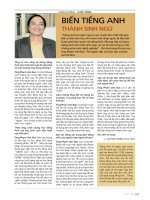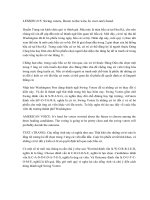tienganhnhomnhom docx
Bạn đang xem bản rút gọn của tài liệu. Xem và tải ngay bản đầy đủ của tài liệu tại đây (1.01 MB, 21 trang )
The topic of
presentation:
Unemployment
Group 12: D4.QL6
1. Hoàng Thị Loan (1990) – Group
leader
2. Lê Thị Anh Vân
3. Lê Phương Thảo
4. Phạm Thị Lan
The content
I- Definition of unemployment
II- Forms of unemployment
1. Classified unemployed
a. By the wills of workers
b. The nature of unemployment
2- Characteristics of unemployed
III- Unemployment in Vietnam
IV- The solution
2
I- Definition of unemployment
Unemployment is the condition of being
without a job and the resulting income that is
necessary to meet economic needs
independently. the term is usually applied by
economists and government statisticians only to
those people without jobs who want to and are
able to work.
By the International Labor Organization (ILO):
"Unemployment is a situation exists when a
number of people in the workforce want to work
but can not find jobs at wages are prevalent”
Unemployment is the state of an
individual looking for a paying job but not
having one.
Unemployment is defined as by the
Bureau of Labor Statistics (BLS) as
people who do not have a job, have
actively looked for work in the past four
weeks, and are currently available for
work. Also, people who were temporarily
laid off and are waiting to be called back
to that job are counted as unemployed.
II – FORMS OF UNEMPLOYMENT
CLASSIFIED UNEMPLOYED
CHARACTERISTICS OF
UNEMPLOYED
By the wills
Of workers
The nature
Of
unemployment
By
age
By
gender
By the
Level of
Technical
expertise
By
region
1- Classified unemployed
a- By the wills of workers
-
Voluntary unemployment:
status of the workers do not
want to work with a specific
salary on the labor market
(because wages are not as
desired by employees).
- Unemployment isn’t volunt ary:
phenomenon is capable of
workers labor in the working
age, have a desire to work but
no work by recession, a larger
labor supply for labor.
b -
T
T
he nature of unemployment
he nature of unemployment
- U
- U
nemployment due to economic stagnation
nemployment due to economic stagnation
:
:
and
and
unemployment when there is a certain
unemployment when there is a certain
percentage of workers in the labor force without
percentage of workers in the labor force without
a job search due to stagnation of the economy. it
a job search due to stagnation of the economy. it
appear as acute as cycle length, shorter
appear as acute as cycle length, shorter
depending on the extent of the economy
depending on the extent of the economy
recession.
recession.
- T
- T
he structural unemployment
he structural unemployment
:
:
the structure of
the structure of
labor supply (mainly based on the level of
labor supply (mainly based on the level of
professional skill, labor structure by sector, by
professional skill, labor structure by sector, by
region) are not suitable for production of goods
region) are not suitable for production of goods
and services.
and services.
- The temporarily unemployed: generated by
the movement of people, between the
domains, between jobs or between different
stages of life.
- Technological unemployment: due to
technological change, technology and
applying techniques. they reduce the demand
for labor in a number of specific job.
- Unemployment needs: unemployment needs
related to the economic cycle, the type of
reduction in unemployment and increase
growth period during the recession
- The seasonal unemployment: seasonal
unemployment depending on the season
of the year, especially in agriculture and
some processing food industry and
construction.
- Short-term unemployment: unemployed
less than three months, unemployment in
the medium term of three months to
twelve months, the long-term
unemployed twelve months.
- Chronic unemployment:
Unemployment is chronic long-term
phenomenon usually occurs with a
certain population groups such as
youth, women, disabled people
- Unemployment tangible.
Unemployment statistics are tangible
and difficult disguised unemployment
statistics, this category can include full
or in part.
2- Characteristics of unemployed
- By age: Unemployment tends to most in the
youngest age group, declining to the working
age.
- By gender: unemployment rate of unemployment
usually higher in women than men.
- By the level of technical expertise: people with
high professional qualifications are unemployed
less.
- By region: proportion of workers in urban areas
are higher than the rate of unemployment in rural
areas.
III - Unemployment in Vietnam
Unemployment rate in 2009 was 4.66%
19 / 1, Ministry of Labor - Invalids and Social
Affairs said the unemployment rate in urban
areas of Vietnam in 2009 is 4.66%.
As an expert in the field of labor, to assess
more accurately the situation of labor and
employment in the economy, need to add other
criteria is the ratio of workers lacking jobs. This
criterion should be calculated for all workers in
rural areas and urban areas.
In Vietnam, the
proportion of workers
lacking jobs are usually
higher than the
unemployment rate. In
particular, rural areas often
lack employment rate
higher than urban.
III - Unemployment in Vietnam
In 2009, the percentage
of Vietnam's lack of
employment at 5.1%.
Notably, the
proportion of
employment in rural
areas lack of up to
6.1%, also in urban
areas is 2.3%.
As reported by the Ministry of Labor - Invalids
and Social Affairs, 2009, the country has created
jobs for 1.51 million workers, reaching 88.8% of
the plan year in which created jobs in the country
is 1.437 million people and export over 73,000
people working.
In 2010, the Ministry set a target to create jobs
for 1.6 million workers. In particular, employment
in the country is 1.515 million, labor export is
85,000 people. In addition, the Ministry is striving
to reduce unemployment in the age in urban areas
to below 4.7%.
IV- The solution
- Reduce labor supply in urban
areas through measures reduce
the rate of natural population
growth, issued the policy to
reduce the rate of migration
from rural areas to urban areas,
enhance economic
development in the region rural
areas with the object of
encouraging qualified to work in
rural areas.
- Advanced development
of human resources.
implementation of
vocational programs,
education, training,
compliance with the
requirements of society,
training needs based on
economic orientation.
- Support jobs for the
unemployed and lack of
jobs. to build and
promote the work of
service, employment,
and network information
on the labor market. With
the development of the
insurance system for
work in the social
security system.
- Expanding export market labor. sending
laborers to work abroad, increasing
sources of foreign exchange, economic
development of the country.
- Economic development in urban areas
to create jobs and guarantee jobs.
application of measures to maximize the
economic and social advantages to create
jobs for workers. implement economic
structure of industrial - service -
agriculture.









